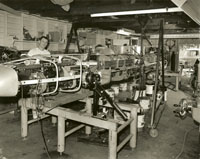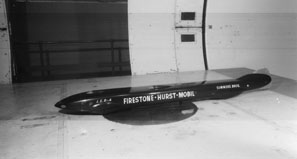| |
 |
 |
Midway through 1965, Bob Summers pauses briefly while putting his complex creation together in a building where people once bought vegetables. |
Tests of a wood model of the car in the Cal Tech wind tunnel resulted in the addition of a tail fin for improved stability at 400+ mph. The lighter color of the added fin contrasts sharply with the dark paint on the original model. |
Goldenrod was built by a pair of California hot rodders, brothers Bill and Bob Summers. For years they participated in the annual Speed Weeks competition at Utah’s vast Bonneville Salt Flats, where they went as fast as 323 miles per hour in a car they built themselves. In 1963 they decided to go after the absolute land speed record of 394.196 mph, set by John Cobb in 1947. Cobb was one of a succession of wealthy Englishmen who had held the record over the years, driving well-financed cars powered by huge airplane engines.
Before Bob and Bill could get started, another Englishman, Donald Campbell, broke Cobb’s record with a speed of 403.10 mph. In 1964 and 1965 other American hot rodders used cars powered by jet aircraft engines to push the record to over 600 mph. But many people, like the Summers brothers, thought using jet engines wasn’t quite fair—they believed that real cars were driven by friction between tires and the ground. So no jet engines for Bob and Bill.
The Summers brothers believed that the key to a successful car was minimizing the resistance of air flowing over the moving car--and that the best way to do this was to make the car as small as possible. To put it simply: it is easier to punch a small hole through the air than a large hole. After testing models in a California Institute of Technology wind tunnel, they designed a car lower and narrower than any land speed record contender in history—48 inches wide, 42 inches high at the top of the tail fin, and only 28 inches high at the engine covers. Into this slim space they packed a quartet of 426 cubic inch Chrysler “hemi” V8 engines and the machinery necessary to power all four wheels. At the extreme rear sat the driver, Bob Summers. It was an amazing feat of engineering, and was so logical and successful that it set the paradigm for future Bonneville streamliner racers. Over 40 years later, long and slim is still the way these cars are built.
Financing Goldenrod was as big a challenge as actually building it. As land speed record cars go, Goldenrod was an economy car. Its $250,000 cost was well below the $3,000,000 Donald Campbell needed to build the car whose record Goldenrod broke. But $250,000 was far more than the Summers brothers had. So they beat the bushes searching for companies who would help pay the costs in exchange for having their corporate name on the car. The turning point came when George Hurst, maker of specialty gear shifting mechanisms and forged wheels, agreed to be a sponsor. Firestone Tire & Rubber then signed on to make the special low profile tires and wheels needed to fit inside the narrow envelope of the body. Chrysler Corporation agreed to loan the brothers four “hemi” engines, while Mobil Oil provided fuel and funding.
Construction on Goldenrod began in January 1965 in a shop that had once been a vegetable stand. By August the machine was done, and in September the brothers were at Bonneville working out the bugs that were inevitable in a car this innovative and complex. After two months of testing and modification all was ready. On November 12, Bob Summers blasted down the Bonneville salt with a run of 417 mph. International rules required two runs, in opposite directions, within one hour. After the car was thoroughly inspected, he set off on his return run with only five minutes to spare. His second run was good enough for a two-way average of 409.277 mph.
The brothers had their record. It would stand for over 25 years.
| |
-- Bob Casey, Curator of Transportation |
Saving a National Treasure
Goldenrod’s record was not broken until 1991, which is part of the reason the car never returned to Bonneville. No sponsors were interested in funding the Summers brothers in an attempt to break their own record. Chrysler even took back its engines, which had only been on loan. Rather than returning to the salt, Goldenrod hit the car show circuit, touring America and even Europe. Sadly, Bob Summers died in 1992, pretty much ending any chance that Goldenrod would race again. The Henry Ford purchased the car from Bill Summers and Bob’s widow Rebecca in 2002.
The years had not been kind to the car and salt residue was corroding the chassis. To preserve the car, we turned to the kind of people who built it--Southern California hot rodders. Part of the funding for the project came from federal government program to preserve nationally significant intellectual and cultural artifacts—the Save America’s Treasures program. Veteran Bonneville racer Mike Cook headed the team of craftsmen who took Goldenrod apart, cleaned or replaced corroded metal, fixed parts damaged over the years, and repainted the aluminum body the original color--1957 Chevrolet Anniversary Gold.
In September 2006, with Bill Summers, Bob Summers’ son and daughter, and Mike Cook in attendance, Goldenrod went on display at The Henry Ford. |
|
|

